| 08:30 |
Registration
|
| 09:00 |
President's Introduction
Philip Friel
|
| 09:09 |
Session 1
Moderator: Karen Walker, ADI DCP Representative
|
| 09:10 |
The impact of cone beam CT imaging when placing dental implants Whilst there is ample evidence about the technical and dimensional accuracy of cone beam CT imaging, there is very little evidence to evaluate its impact on treatment planning or patient outcome when dental implants are placed. A unique dental simulation was developed in which reproducible cases, including a range of different images, could be presented to implant practitioners. The practitioners were asked to drill osteotomies for implant placement in the anterior mandible, guided by different image types. Only very weak evidence was found that the availability of CBCT led to fewer perforations in challenging cases. For regular cases, CBCT was found to have no effect on the incidence of perforations. This research is unique in addressing patient outcome and by investigating the impact of the availability of CBCT prior to dental implant placement in the edentulous anterior mandible.
Andrew Shelley 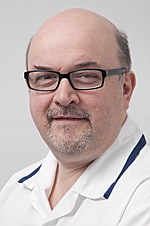 Andrew Shelley is in specialist practice in Manchester, UK. Qualified in 1979, he is a Fellow of the Royal Colleges of Surgeons of Edinburgh and of England. He has a special interest in imaging prior to dental implant placement and is currently researching the impact of cone beam CT technology on treatment planning and patient outcomes. Andrew is a co-author of the FGDP(UK)’s Selection Criteria for Dental Radiography. Andrew Shelley is in specialist practice in Manchester, UK. Qualified in 1979, he is a Fellow of the Royal Colleges of Surgeons of Edinburgh and of England. He has a special interest in imaging prior to dental implant placement and is currently researching the impact of cone beam CT technology on treatment planning and patient outcomes. Andrew is a co-author of the FGDP(UK)’s Selection Criteria for Dental Radiography.
Qualifications: PhD MSc BDS MFGDP(UK) DPDS MGDS RCSEd FDS RCSEd FFGDP(UK) Dip Rest Dent RCS Eng
|
| 09:35 |
The loneliness of the long distance dental hygienist....who may be treating your patients under direct access or in the room next door! This presentation will address the issues of the dental hygienist working in "isolation" and treating implant patients. In today's society when patients are opting for more complex and costly treatment and indeed in a more litigious world we need to "team up"! Are hygienists finding it difficult navigating unchartered waters alone; are we anchorless without our "Holy Grail", the periodontal ligament? If implant dentists are the mad professors of dentistry, does that make them notoriously bad at communicating with dental hygienists? Are we the hygienists to blame - should we "Storm the Bastille" - involve ourselves more? Become more knowledgeable about the implant process? Do we need to up our game? Join dental implant societies/study groups? After 25 years of treating implant patients I would like to find solutions to the day to day problems that arise from lack of communication between the implant dentist and the hygienist - we need to talk...
Julia Wilson 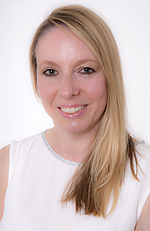 Julia Wilson’s career in dentistry began at Kings College Dental School where she undertook a DSA course after which she went on to study dental hygiene at Leeds Dental Institute when on graduating Julia enjoyed both diverse and interesting work in hospital and general practice in Yorkshire. It was a return to London and meeting Peter Fairbairn that brought her into the world of dental implants. In addition to working in the West End and the City she has enjoyed working alongside Peter for nearly 25 years. She is a member of the BSP, BSDHT and the ADI. She has previously written articles for DH&T and presently enjoys giving talks for Bupa dental hygienists. Julia Wilson’s career in dentistry began at Kings College Dental School where she undertook a DSA course after which she went on to study dental hygiene at Leeds Dental Institute when on graduating Julia enjoyed both diverse and interesting work in hospital and general practice in Yorkshire. It was a return to London and meeting Peter Fairbairn that brought her into the world of dental implants. In addition to working in the West End and the City she has enjoyed working alongside Peter for nearly 25 years. She is a member of the BSP, BSDHT and the ADI. She has previously written articles for DH&T and presently enjoys giving talks for Bupa dental hygienists.
Qualifications: RDH
|
| 10:00 |
A combined surgical and implant restorative approach in a case of cleidocranial dysplasia - a case report Cleidocranial dysostosis can clinically be represented in many ways, but some of the biggest quality of life affecting parts of this condition are those involving the adult dentition. Failure of eruption of the adult dentition is commonly seen in cleidocranial dysostosis and this is commonly treated through orthodontic treatments. This orthodontic treatment may not always be successful, however. This case report shows how dental implants may instead be used to restore the dentition, providing both functional and aesthetic results.
Matthew Miller  Matthew Miller qualified from Peninsula Dental School in 2013. Matthew previously studied Biology at Liverpool University. Matthew Miller qualified from Peninsula Dental School in 2013. Matthew previously studied Biology at Liverpool University.
Matthew began work as a DF1 trainee on the UCL Eastman scheme. It was during this time that Matthew developed a keen interest in dental implantology.
Matthew currently works as a Maxillofacial SHO at Torbay District General Hospital and has been active in many dental specialities during his time at Torbay. Matthew has a particular interest in research and evidence based dentistry. Matthew was delighted to be awarded First Prize for his poster presentation at the 2015 ADI Team Congress in Glasgow.
Matthew currently lives in Devon.
Qualifications: BDS BSc(Hons) MFDS
|
| 10:25 |
Panel discussion
Moderator and Preceding Speakers
|
| 10:40 |
Tea/Coffee & Exhibition
|
| 11:00 |
Peri-implantitis: A future timebomb? Dental implants are becoming a popular modality for the replacement of missing teeth both by the public and the clinician. Approximately 140,000 implants are being placed in the UK and when one looks at the evidence there is a significant increase in peri-implantitis within this cohort of patients. There is some controversy regarding the actual cause of peri-implantitis but the main risk factors are similar to periodontitis. This presentation will cover some of the evidence on how to monitor dental implants and to treat perimucositis and peri-implantitis to help increase the longevity of our patients’ dental implants.
Amit Patel 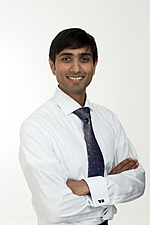 Amit Patel is registered with the General Dental Council as a Specialist in Periodontics. His special interests are dental implants, regenerative and aesthetic Periodontics. Amit Patel is registered with the General Dental Council as a Specialist in Periodontics. His special interests are dental implants, regenerative and aesthetic Periodontics.
Amit graduated from the University of Liverpool and completed a 4 year specialist training programme in Periodontics at Guy’s, King’s & St Thomas’ Dental Institute.
Amit then obtained his Membership in Restorative Dentistry from the Royal College of Surgeons of England and became a registered Specialist in Periodontics. He has worked with several different implant systems, lectured both nationally and internationally and published in the field of Dental Implantology and Periodontics.
Amit is also an Associate Specialist in Periodontics at the Birmingham Dental School. He has taught at undergraduate and postgraduate level, including lecturing to dental practitioners both in the UK and internationally. Amit is also the principal specialist and director at Birmingham Dental Specialists.
Qualifications: BDS MSc MClinDent FDS RCSEd MRD RCSEng
|
| 11:25 |
Implant surfaces and peri-implantitis, from surface to suppuration Peri-implant disease is a growing problem in implant dentistry today. Despite our best efforts to refine implant design and surface features the problem persists, and in some cases appears to be growing. As more and more implants are placed by clinicians of varying skill levels and clinical backgrounds the numbers of patients presenting with the disease is increasing. Dental implant surfaces have evolved from the machined surfaces of the early Branemark implants, through to nano-featured surfaces with reported ‘bio-active’ features. This has led to more rapid and stronger osseo-integration and shorter treatment times. However, is there potential for the surface topography and chemistry to influence the initiation and treatment of peri-implant disease? This lecture outlines the basic features of dental implant surfaces and the possible impact on the initiation and treatment of peri-implant disease, as well as our clinical decision making when treating an implant with peri-implantitis.
David Holmes 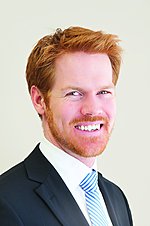 David Holmes obtained his dental degree from the University of Sydney graduating with honours in 2002. He worked in private dental practice for four years before moving in 2006 to New York University (NYU) to pursue his interest in dental implants and reconstructive dentistry. During the four years he spent at NYU he received a Certificate in Implant Dentistry from the Department of Periodontology and Implant Dentistry, a Master of Science degree (Biomaterials and Biomimetics) and was assistant research scientist in the department of Biomaterials and Biomimetics. David Holmes obtained his dental degree from the University of Sydney graduating with honours in 2002. He worked in private dental practice for four years before moving in 2006 to New York University (NYU) to pursue his interest in dental implants and reconstructive dentistry. During the four years he spent at NYU he received a Certificate in Implant Dentistry from the Department of Periodontology and Implant Dentistry, a Master of Science degree (Biomaterials and Biomimetics) and was assistant research scientist in the department of Biomaterials and Biomimetics.
He has presented at numerous international and national dental implant, periodontic and prosthodontic meetings, including the Academy of Osseointegration, the North Eastern Society of Periodontists, The North Eastern Implant Symposium and The American Prosthodontic Society. He has co-authored a textbook chapter as well as multiple peer reviewed journal articles. Currently he works in private practice limited to implant and reconstructive dentistry in central London.
Qualifications: BDS Hons (USyd) Cert Imp Dent (NYU) MS (NYU)
|
| 11:50 |
Immediate placement and loading in advanced periodontitis in the maxilla utilising intra-oral welding - a case study This is a case of advanced periodontitis where none of the maxillary teeth could be saved. A full assessment was done including a CBCT scan of the upper arch. The only replacement options acceptable to the patient were fixed prosthesis. The patient was not prepared to accept a removable prosthesis even as a temporary measure. The case was therefore planned as an immediate placement of six implants in maxilla, with simultaneous lateral approach sinus lifts, immediate loading with all implants splinted at abutment level by means of intra-oral welding. A shell of a denture that was made for the patient was then connected to the splinted abutments. This prosthesis was worn by the patient for a period of 6 months, during which he was attending the clinic for maintenance. Afterwards, the construction of the final definitive appliance was done. All implants were fully integrated and treatment was completed in May 2015.
Irene Amrore 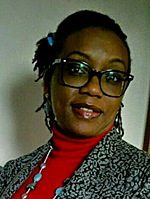 Irene Amrore obtained her undergraduate degree in dentistry in 1994. Between the years 1997 and 2001, Dr Amrore worked as a Senior House Officer/Staff Grade Oral Surgeon in a number of Hospitals in the UK where she gained skills and experience in surgical dentistry. She has run her own Dental Practice in the UK for over 10 years and has been practising implant dentistry for 11 years. Included in her academic acquisitions are a Masters Degree in Implant Dentistry from the University of Warwick UK (2012) and a Postgraduate Degree in Medical Education from University of Cardiff, Wales (2014). Dr Amrore is involved in implant mentoring programmes in Nigeria and the UK. She is a full member of the Faculty of General Dental Practitioners, Royal College of Surgeons of England and is on the ADI Register of Mentors. Irene Amrore obtained her undergraduate degree in dentistry in 1994. Between the years 1997 and 2001, Dr Amrore worked as a Senior House Officer/Staff Grade Oral Surgeon in a number of Hospitals in the UK where she gained skills and experience in surgical dentistry. She has run her own Dental Practice in the UK for over 10 years and has been practising implant dentistry for 11 years. Included in her academic acquisitions are a Masters Degree in Implant Dentistry from the University of Warwick UK (2012) and a Postgraduate Degree in Medical Education from University of Cardiff, Wales (2014). Dr Amrore is involved in implant mentoring programmes in Nigeria and the UK. She is a full member of the Faculty of General Dental Practitioners, Royal College of Surgeons of England and is on the ADI Register of Mentors.
Qualifications: Stat MSc PGCertME MFGDP FHEA
|
| 12:15 |
Panel discussion
Moderator and Preceding Speakers
|
| 12:30 |
Buffet Lunch & Exhibition
|
| 13:15 |
AGM
|
| 13:16 |
Session 2
Moderator: Steve Moulder, ADI South East England Representative
|
| 13:45 |
Immediate loading of implant over-dentures As increasing numbers of fixed "All on 4" style bridges return with complex and costly prosthodontic or biological complications, we have seen renewed interest in over-dentures. In private referral practice in Edinburgh, we have been working extensively with over-dentures since the clinic opened in 2011. Immediate loading of implant over-dentures using locator abutments in the mandible is described in the literature, but immediate loading with a removable prosthesis in the maxilla has always been regarded as too risky. We will share our outcomes over the past four years, reporting on 27 maxillary and 27 mandibular over-denture cases. We will describe in brief the surgical and restorative techniques, and share the results of the independent analysis of our data conducted by Professor Hugo De Bruyn, University of Gent in relation to clinical examination, radiographic examination and quality of life improvement.
David Offord 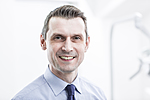 David Offord is a specialist in oral surgery and practice principal at Vermilion – The Smile Experts, a private referral clinic established in Edinburgh four years ago. Dr Offord qualified from the University of Edinburgh in 1994, and has limited his practice to oral surgery since 2000. The nine-strong clinician team at Vermilion include three prosthodontists and two oral surgeons who work in close collaboration on implant cases, in particular around immediate loading of single crowns and full-arch cases, fixed or removable. Their work on immediate loading of implant retained over-dentures has resulted in a research collaboration with the University of Ghent, Belgium. David Offord is a specialist in oral surgery and practice principal at Vermilion – The Smile Experts, a private referral clinic established in Edinburgh four years ago. Dr Offord qualified from the University of Edinburgh in 1994, and has limited his practice to oral surgery since 2000. The nine-strong clinician team at Vermilion include three prosthodontists and two oral surgeons who work in close collaboration on implant cases, in particular around immediate loading of single crowns and full-arch cases, fixed or removable. Their work on immediate loading of implant retained over-dentures has resulted in a research collaboration with the University of Ghent, Belgium.
Qualifications: BDS MFDS Dip.Con.Sed
|
| 14:10 |
Can we make an adjustable abutment with 0-36 degrees freedom of orientation? This new abutment system provides a selectable 36 degree freedom in the vertical axis for restorative requirements. The surgeon can place the chosen implant at the most appropriate angle to take advantage of the available bone and then select a chosen emergence for screw attachment of the immediate or definitive prosthesis. Additionally, this abutment system can offer 100% passivity with the luting stage for restorative frameworks both clinically and within the laboratory. The design has platform switching and allows surface coating of the abutment for soft tissue integrity. Early clinical and radiographic results for immediate loading of full arch frameworks with multiple implants will be presented illustrating the mechanisms and advantages of this adjustable abutment system.
W Duncan Robertson 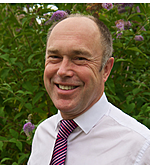 Born in Zimbabwe in 1959, Duncan Robertson returned to Scotland in 1976 before studying dentistry in Edinburgh in 1978. He qualified in 1983 having won the British Densply Student Clinician prize with a paper ‘A Polycarboxylate Dental Cement Containing Hydroxyapatite’. Born in Zimbabwe in 1959, Duncan Robertson returned to Scotland in 1976 before studying dentistry in Edinburgh in 1978. He qualified in 1983 having won the British Densply Student Clinician prize with a paper ‘A Polycarboxylate Dental Cement Containing Hydroxyapatite’.
Following a year at Edinburgh Dental Hospital, he began clinical and laboratory research after being awarded the Leckie Macatier Fellowship. His PhD entitled ‘Oral Keratoses’ was awarded by Edinburgh University in 2001.
Duncan started his dental practice in 1993 in Fairmilehead, Edinburgh. His interest in implantology developed from single units to multiple immediate loading cases. He recently applied for British and world patents for an adjustable abutment offering a range of selectable angulations and his design is now at the proof of concept stage.
Duncan has a keen interest in treatment planning in general practice and is an examiner with the RCS Edinburgh and a member of ITI, BSOS and ADI.
Qualifications: BDS MFGDP(UK) FDS RCS (Edin) PhD
|
| 14:35 |
Case study with a complicated medical history The patient had a complicated medical history and presented with acute pulpitis of the lower right first molar. In view of his medical history, i.e. type II diabetes and immunosuppression as a result of a liver transplant (not alcohol related), the clinical dilemma was RCT or extraction and an implant. On balance it was decided to refer him for RCT - this failed so I advised the patient I would consult with his oncologist - particularly in view of his immunosuppression - but I gave a very guarded prognosis regarding the extraction of the tooth and placing one endosseous implant (he did not want a bridge!). The tooth was extracted and one implant placed in 2012. An IAC (Integrated Abutment Crown - no screw or cement) was placed 5/12 later. To date this case has been a success. My presentation will also illustrate aids garnered over my 40+ years in implantology.
John Stowell 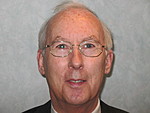 John Stowell graduated firstly from the RCS (Eng) and then gained a BDS from Durham University. Subsequently he gained the FDSRCS from Edinburgh University. John Stowell graduated firstly from the RCS (Eng) and then gained a BDS from Durham University. Subsequently he gained the FDSRCS from Edinburgh University.
He held House Officer posts in Conservation & Oral Surgery in Newcastle Dental School before holding the post of Registrar in OMFS in North Manchester Hospital. He became a P/T lecturer in Oral Surgery in the University of Manchester Dental School before moving on to become an Associate Specialist in Oral and Maxillo-Facial Surgery based in the Royal Albert & Edward Infirmary in Wigan. He retired from the post in 2009 but has maintained his private practice in Woodvale Clinic in Knutsford since 1975.
He was awarded an Associate Fellow of the AAID by examination in 1992 and was made an Honoured Fellow of the AAID in 2010.
He has lectured nationally and internationally for many years on implantology.
Qualifications: LDRCS(Eng) BDS(Dunelm) FDSRCS(Edin)
|
| 15:00 |
Panel discussion
Moderator and Preceding Speakers
|
| 15:15 |
Tea/Coffee & Exhibition
|
| 15:30 |
Novel grafting materials, a way to simplify treatment? Modern grafting materials have enabled the development of novel techniques to enable more streamlined and less invasive placement of dental implants in compromised sites. With the use of synthetic materials that are both mechanically stable and fully bioabsorbed, which seem to illicit a much reduced host response on placement, it has been possible to change our protocols fundamentally. Implants can now be placed concurrently with the graft without the use of a collagen membrane, with the reliable production of vital host bone. My aim is to share the experience of a non-specialist GDP who places implants and the benefits of these techniques to my patients over the last 8 years.
Michael Ainsworth 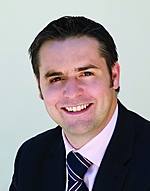 Michael Ainsworth graduated from Birmingham University in 2002 and has been in private practice since that time. He became very interested in complex and cosmetic dentistry immediately, attending many courses and conferences both at home and abroad and started placing implants under supervision soon thereafter, completing a 1 year certification course in 2004. Over the course of the last decade and under the mentorship of Peter Fairbairn he has developed a keen interest in streamlining techniques for the use of synthetic biomaterials in bone grafting, and soft tissue development. In 2007 he moved to Spain to run a private practice. Since returning to the UK he has worked in a number of practices in Yorkshire and the West Midlands. He is currently undertaking an MSc in Periodontology and has limited his practice to dental implant treatments. Michael Ainsworth graduated from Birmingham University in 2002 and has been in private practice since that time. He became very interested in complex and cosmetic dentistry immediately, attending many courses and conferences both at home and abroad and started placing implants under supervision soon thereafter, completing a 1 year certification course in 2004. Over the course of the last decade and under the mentorship of Peter Fairbairn he has developed a keen interest in streamlining techniques for the use of synthetic biomaterials in bone grafting, and soft tissue development. In 2007 he moved to Spain to run a private practice. Since returning to the UK he has worked in a number of practices in Yorkshire and the West Midlands. He is currently undertaking an MSc in Periodontology and has limited his practice to dental implant treatments.
Qualifications: BDS
|
| 15:55 |
Immediate loading in grafted sites - a recipe for disaster or an accepted treatment modality? To minimise the risk of implant failures after their placement, dental implants are traditionally kept load-free for 3 to 6 months to establish osseointegration (conventional loading). It would be beneficial if the healing period could be shortened without jeopardising implant success. Nowadays dental implant patients’ expectations for better and quicker implant therapy is putting clinicians under pressure to load dental implants immediately to minimise the discomfort from temporary prosthesis. However, most of the implant aesthetic cases will require simultaneous guided bone regeneration to enhance aesthetics and long term peri-implant tissue stability. The different clinical views on immediately loading dental implants in association with guided bone regeneration will be discussed, in addition to presenting the latest evidence on this controversial topic, in an attempt to find out whether it is possible and predictable to immediately load dental implants in cases when guided bone regeneration is needed in aesthetic cases.
Hassan Maghaireh 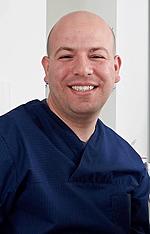 Hassan Maghaireh completed five years’ training in various maxillofacial units in the UK, gaining his membership in the Royal College of Surgeons in Edinburgh by Examination. He then gained a Clinical Masters degree in Implant Dentistry from the University of Manchester winning the best clinical presentation award in 2008. Dr Maghaireh maintains a private implant referral practice in Leeds, and also acts as a mentor and Honorary Clinical Lecturer in Implantology at the University of Manchester. Hassan has a special interest in Evidence Based Implant Dentistry and is actively involved in the oral health group of the Cochrane collaboration. He is on the editorial board for the European Journal of Oral Implantology. Dr Maghaireh is the head of the scientific committee at The British Academy of Implant & Restorative Dentistry (BAIRD) and a mentor for ADI, ITI, Straumann, Megagen and other implant systems. He is the clinical director of the one-year Clinical & Evidence Based Dental Implantology course in Leeds, Qatar, Bahrain, Emirates Jordan and Croatia. Hassan Maghaireh completed five years’ training in various maxillofacial units in the UK, gaining his membership in the Royal College of Surgeons in Edinburgh by Examination. He then gained a Clinical Masters degree in Implant Dentistry from the University of Manchester winning the best clinical presentation award in 2008. Dr Maghaireh maintains a private implant referral practice in Leeds, and also acts as a mentor and Honorary Clinical Lecturer in Implantology at the University of Manchester. Hassan has a special interest in Evidence Based Implant Dentistry and is actively involved in the oral health group of the Cochrane collaboration. He is on the editorial board for the European Journal of Oral Implantology. Dr Maghaireh is the head of the scientific committee at The British Academy of Implant & Restorative Dentistry (BAIRD) and a mentor for ADI, ITI, Straumann, Megagen and other implant systems. He is the clinical director of the one-year Clinical & Evidence Based Dental Implantology course in Leeds, Qatar, Bahrain, Emirates Jordan and Croatia.
Qualifications: BDS MFDS MSc (Implants)
|
| 16:20 |
Autogenous block bone grafts – long-term results This presentation will focus on the techniques and principles of reconstructing bone deficiencies using autogenous block bone grafts to create the ideal site for implant placement. Biological principles underlying the healing of autogenous block bone grafts will be addressed. The clinical management of patients will be described based on the fundamental principles of:
(i) Appropriate flap design and soft tissue management;
(ii) Adaptation of the graft to the recipient site to achieve contact healing (osteo-synthesis);
(iii) Stability of graft to prevent micro-movement.
Fundamental principles of functional stimulation of the bone grafts resulting in stable hard and soft tissues will be addressed as a basis for stable long-term aesthetic results. Clinical cases demonstrating long-term stability will be presented along with long-term survival rates.
Ashok Sethi 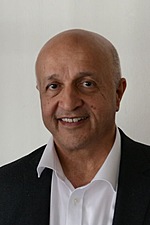 Ashok Sethi has pioneered, in the UK and internationally, the art and science of surgical and restorative implant dentistry for 34 years. His practice is totally dedicated to implants achieving outstanding success rates in terms of predictability as well as aesthetic and functional outcome. Ashok Sethi has pioneered, in the UK and internationally, the art and science of surgical and restorative implant dentistry for 34 years. His practice is totally dedicated to implants achieving outstanding success rates in terms of predictability as well as aesthetic and functional outcome.
He conceived and taught the Diploma in Implant Dentistry, of the Royal College of Surgeons of England.
He is the director of the recently established PID – Academy providing postgraduate education and training in practical implant dentistry.
He is a founding member and Past President of the ADI and has been elected as an Honorary Member of the Association.
He has written a book “Practical Implant Dentistry” jointly with Thomas Kaus, which is published by Quintessence International and has been translated into 10 different languages. The 2nd edition “Practical Implant Dentistry–the Science and Art” is now available.
Qualifications: BDS DGDP(UK) MGDSRCS(Eng) DUI(Lille) FFGDP(UK)
|
| 16:45 |
Panel discussion
Moderator and Preceding Speakers
|
| 17:00 |
Close of Forum, followed by Drinks Reception
|